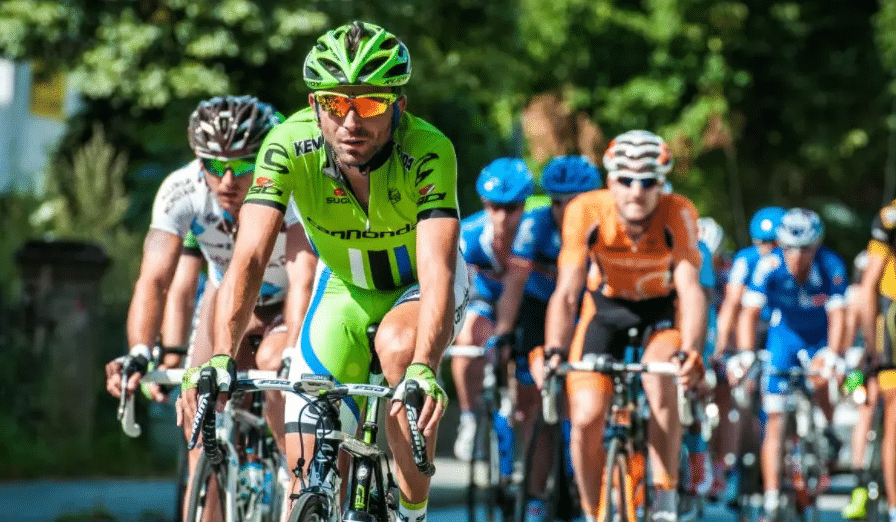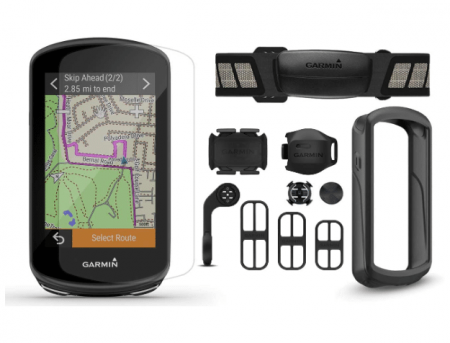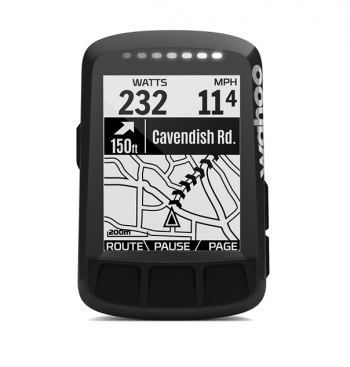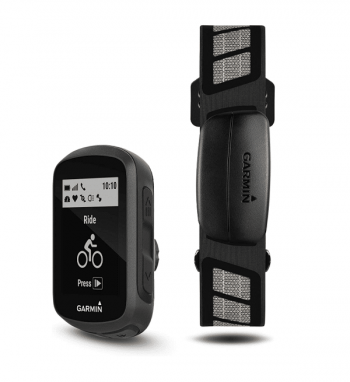Need a cycling computer with a heart rate monitor to keep track of your cycling stats? Read on for our buyer’s guide and to learn more about the best models available today!
Best Bluetooth Fitness Cycling Computer With Heart Rate Monitor
QUICK SUMMARY: Need a cycling computer with a heart rate monitor to keep track of your cycling stats? Read on for our buyer’s guide and to learn more about the best models available today.

Table of Contents
The Best Cycling Computer With Heart Rate Monitor Reviewed
Whether you’re looking to train for a race or you just want to stick to your fitness goals, a bike or cycling computer with a heart rate monitor is a sure bet.
Why?
Well, bike computers with heart rate monitors allow you to keep track of your performance stats, like your ever-important heart rate, while also giving you directions, notifications, and other useful features while you’re on the road.
However, finding the right cycling computer with a heart rate monitor can be tricky because these small devices come jam-packed with high-end technology.
To ensure that you have the gear you need to take to the road on your next bike ride, we’ve put together this list of the best bike computers on the market today, plus a guide to selecting the right model for your needs.
Let’s get started!
Garmin Edge 1030 Plus Bundle
Where to buy Garmin Edge 1030 Plus Bundle
Completely compatible with Bluetooth, ANT+, and even InReach satellite communication devices, this computer can send and receive messages, training data, and other information throughout your ride.
The bundle package also comes with a heart rate monitor strap, 2 mounts, a cadence sensor, and a speed sensor to give you the most accurate data possible. It even offers GPS, Galileo, and GLONASS functionality with downloaded maps, plus suggested routes, training plans, and real-time data about your performance.
Finally, the Garmin Edge 1030 Plus comes with a bike alarm system and incident detection technology to keep you and your bike safe on the road.
Wahoo ELEMNT Bolt Bundle
A fan-favorite, the Wahoo ELEMNT Bolt Bundle is an all-inclusive kit for performance and stats-conscious cyclists. This bundle comes complete with the ELEMNT Bolt bike computer, a TICKR heart rate monitor, speed and cadence sensors and all the requisite mounts.
Once everything’s hooked up to your bike, you get access to a fully featured computer with GPS, Bluetooth, and ANT+ compatibility as you ride. The ELEMNT Bolt computer has GPS functionality, pre-downloaded global maps and route downloads, as well as turn-by-turn navigation to guide you as you cycle.
You can even customize your screen displays with this computer to better track your stats, including your heart rate and speed. Alternatively, the ELEMNT Bolt allows you to program up a series of LED indicators to keep you up to date on your performance metrics, notifications, and navigation settings without the need to take your eyes off the road.
Garmin Edge 130 Plus Bundle
For budget-weary cyclists, the Garmin Edge 130 Plus Bundle is hard to beat. Inside this bundle package, you get Garmin’s flagship cycle computer, a standard bike mount, plus an HRM-Dual strap for tracking your heart rate on the road.
Right out of the box, the Edge 130 Plus comes ready to hit the road with GPS, GLONASS, and Galileo satellite connectivity, as well as downloadable routes. It offers enhanced performance monitoring capabilities, including stats like heart rate, VO2 max, and calories burned, all of which can be synced to your smartphone and other devices using Bluetooth or ANT+.
Wrapping up a great list of features on the Edge 130 Plus is a set of enhanced safety systems, including incident detection if you get into an accident, and smart notifications straight from your phone.
Benefits Of A Cycling Computer With A Heart Rate Monitor
These days, a whole lot of cyclists opt to use their smartphone instead of a dedicated cycling computer. But, while it might seem easier and more affordable to let your phone moonlight as a cycling computer, when push comes to shove, it’s hard to argue that a smartphone is the better piece of gear.
Here’s why:
- Better Battery Life.cycling computers come with substantially better battery life than your standard smartphone, which means they can last longer in between charges. Plus, using your phone for recording distances or tracking your speed is a sure-fire way to drain the battery by the end of your ride.
- Improved Accuracy & Precision.Simply put, cycling computers are more accurate than your standard smartphone since they’re designed to do just one job: record your ride. You can also more easily connect them with other devices for improved tracking ability as you pedal.
- Enhanced Durability.cycling computers are meant to sit on your handlebars throughout varying conditions so they’re crafted with super strong frames and screens to hold up over time. Meanwhile, smartphones are known to crack and malfunction after the smallest of drops.
How To Choose A Cycling Computer
Choosing a cycling computer with a heart rate monitor is no walk in the park. As you shop, keep the following key features and functions in mind to ensure you get the right model for your needs.
If you’re reading this article, you’re probably in the market for a cycling computer with a heart rate monitor, so a heart rate sensor should be a feature that’s pretty high on your list.
Most companies that offer a heart rate sensor-compatible cycling computer will also sell a heart rate monitor or strap in a package deal. It’s worth noting however, that you may be able to use your own ANT+ or Bluetooth compatible heart rate strap with certain bike computers instead of buying a new one, so it’s important to check the specs on any model before you buy.
GPS & Map Availability
Depending on where you cycle, you may want to look for a bike computer that offers GPS connectivity and downloadable maps for navigation during your ride. You’ll often have to pay a bit more for these features, but they’re indispensable if you’re looking to take your cycling to new destinations.
Smartphone & Bluetooth Connectivity
If you’d like to upload your ride stats to Strava or another app, you’ll want to ensure that you get a bike computer with Bluetooth connectivity. Bluetooth-compatible computers can sometimes allow you to receive messages and other notifications so you can stay in contact with the rest of your riding group.
Touch Screen vs. No Touch Screen
Most of us are accustomed to using touch screen smartphones and other devices, but you can still get a bike computer without this now-common technology.
In fact, while touch screens may seem like the more intuitive option, some cyclists actually prefer computers with button-operated navigation, instead. That’s because buttons can often be easier to operate when you’re cycling, though this is really more of a personal preference, rather than a hard and fast rule.
Battery Life
For long or frequent rides, you’ll want to invest in a cycling computer with a sizable battery life. At a minimum, your computer should last at least 8 hours, but you can often find models with impressive 20+ hour battery lives.
Mounting System
Cycling computers need to be mounted to your handlebars in order to function properly, so having a mount that works with your bike is key. Most bike computer bundles that include a heart rate strap often come with 1 or more mount options for you to choose from.
Power Meter Functionality
A power meter is a type of device that’s designed to accurately measure your total power output as you bike. These are often attached to your bike’s pedal or crank arm and they can transmit real time data about your power outputs during your ride either through your smartphone or your bike computer.
If you use a power meter, you’ll want to be sure that you get a bike computer that’s compatible with your device. In general, most modern power meters transmit data over ANT+ or Bluetooth, but be sure to check compatibility before you buy
FAQ
How do wireless Cycling computers work?
Most wireless bike computers use Bluetooth or other similar wireless technologies, such as ANT+, which allow for the transfer of data between various sensors and the computer itself. Alternatively, some wireless bike computers, which don’t have sensors rely solely on GPS connectivity to track your route and your cycling data.
Where do you mount a Cycling computer?
Where you mount your bike computer depends on the type of computer that you purchase and the sensors that it comes with.
While the actual screen of the computer is almost always mounted on the handlebars so you can easily see your stats, properly mounting your sensors is equally as important for accurate stats.
You’ll generally want to mount a magnet on the spokes on your front wheels and a sensor on the fork. However, some sensors are actually mounted onto the hub of either wheel or onto the crank arm. Therefore, it’s best to consult with your device’s manual before installation.



